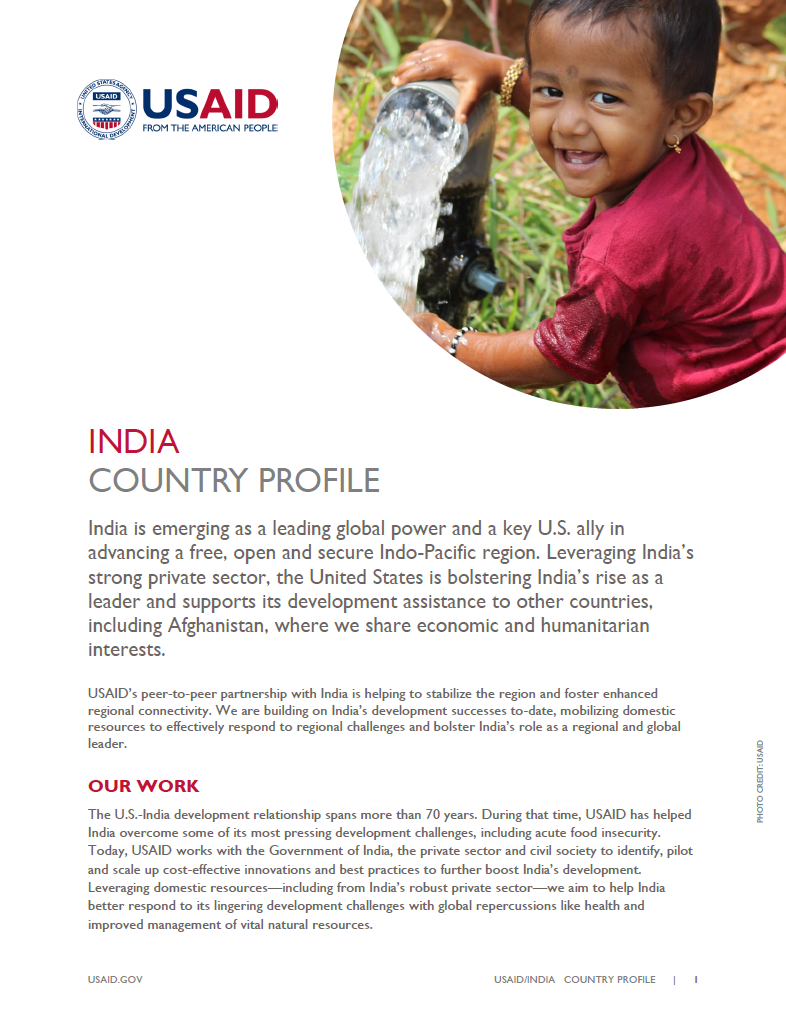India
- History
- Our Work
- Transforming Development Through Innovation & Partnership
- U.S.-India Triangular Cooperation
- Partnership for Energy Access and Security
- Partnership for Sustainable Forests in India
- Partnerships for Health
- Partnership for Education
- Partnership for Water Sanitation and Hygiene (WASH)
- Partnership for Food Security
- Partnership for Gender Equality
- Investing in Afghanistan
- Foreign Assistance Data
- Newsroom
- Newsletters and Fact Sheets
- Speeches
- Resources For Implementing Partners (RFIP)
- Careers
- Partnership Opportunities
- Success Stories
Speeches Shim
![]() (370k) India Country Profile
(370k) India Country Profile
India is emerging as a leading global power and a key ally in the Indo-Pacific region. Despite India’s increased capacity to solve its development challenges, the world’s largest democracy faces the daunting task of providing quality services to its growing population of more than one billion people. The United States partners with India to promote security, stability, and economic prosperity through trade, investment and regional connectivity.
USAID’s peer-to-peer partnership with India is helping to stabilize the region and forge lasting prosperity. We are building on India’s development successes to-date, mobilizing domestic resources to effectively respond to local challenges and bolstering India’s leadership as a fellow donor.
OUR WORK
USAID has helped India overcome some of the country’s most pressing development needs, such as acute food insecurity, while also partnering with the Government of India to manage and implement its development agenda. Building on more than 70 years of development partnership, USAID works with the Government of India, the private sector and civil society to identify, pilot and scale up cost effective innovations and best practices to further boost India’s development. We focus on increasing access to quality health care and sanitation, protecting the environment, and boosting the growth of clean energy.
HEALTH
High rates of child and maternal death, widespread malnutrition, and a high burden TB and HIV threaten the lives of India’s growing population. To improve health and well-being, USAID strengthens the reach, affordability, and quality of health care services. Over the past 15 years, for example, USAID has helped India save 7 million lives through TB interventions. Adding to an already challenging health environment, access to clean water and functioning toilets escapes about 40 percent of the population — making India home to the world’s highest number of diarrhea-related deaths in children under 5. Thanks in part to USAID assistance, more than 1,000 cities have been declared open defecation-free since late 2014, reducing the potential for health hazards.
ENVIRONMENT AND ENERGY
Energy production and consumption accounts for as much as 58 percent of India’s greenhouse gas emissions — and is projected to grow exponentially due to a rising energy demand associated with urbanization, better living standards, and economic modernization. Owing to high levels of greenhouse gas and other toxic emissions, India is home to nine of the world’s ten most polluted cities, according to the World Health Organization. USAID is helping to advance India’s transition to a green, renewable, energy-secure economy by making clean energy cheaper and more accessible. Between 2015 and 2018, USAID helped improve access to modern, clean energy for more than 1.8 million people across nine states, reducing the amount of toxins in the air. Under the Indo-Pacific Strategy, USAID will work to enhance management of natural resources such as increasing water quantity and quality in rivers through improved management of forested watersheds, and reduce water-related conflicts. Lastly, with USAID support, India launched its now-flourishing Green Bond market, allowing investors to focus their funds in activities linked to clean energy and climate resilience.
PROMOTING REGIONAL STABILITY
India plays a critical role in promoting regional stability, including with Afghanistan. Increased trade, cross-border trainings and India’s increased capacity to provide foreign assistance are helping to stabilize and spur economic growth in the region. In 2018, for example, USAID sponsored the second annual India-Afghanistan trade and investment show, which doubled the total value of deals negotiated compared to its inaugural year, strengthening businesses and improving people-to-people ties.


Comment
Make a general inquiry or suggest an improvement.